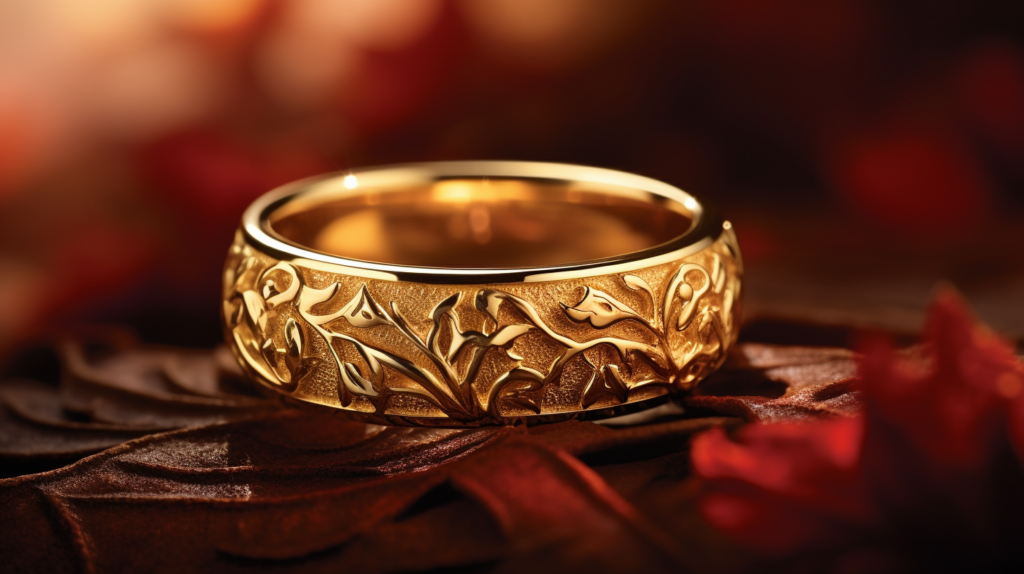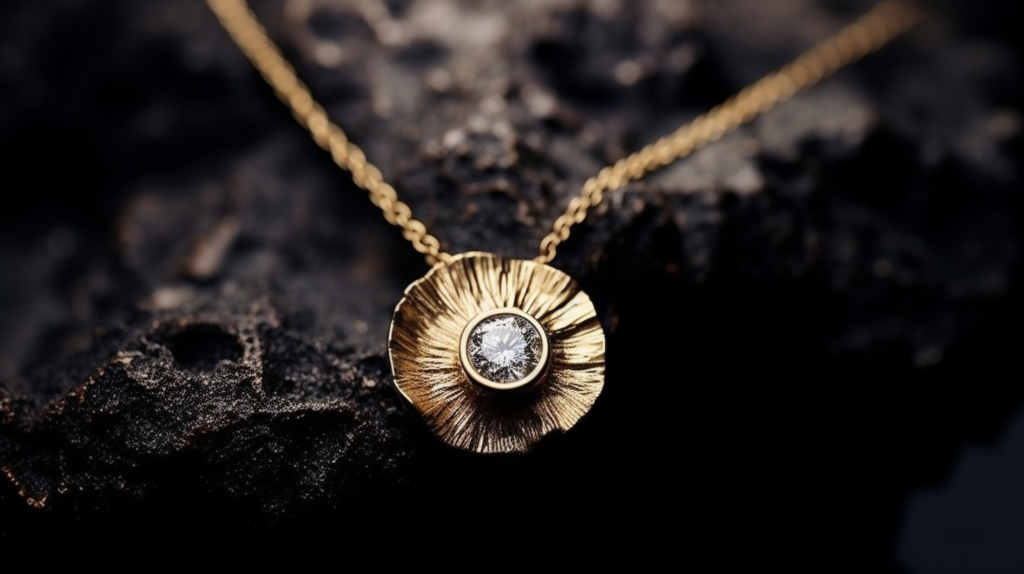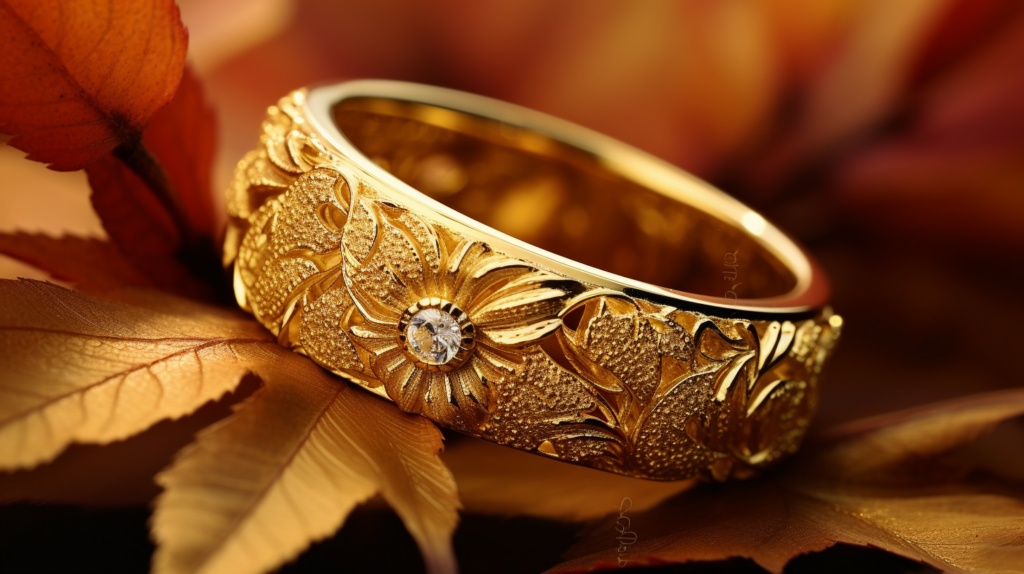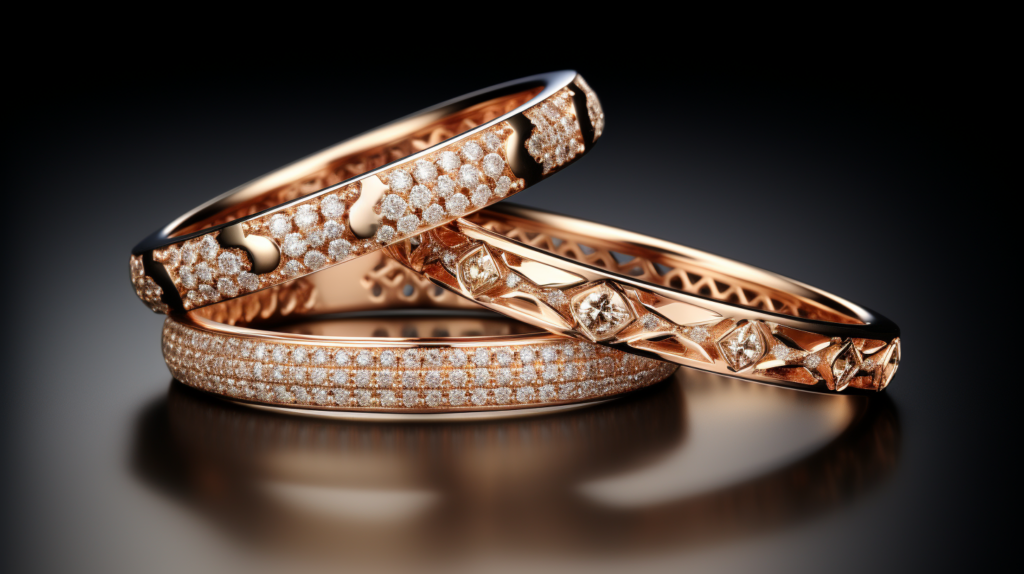18K Gold Buying Guide: Have you ever wondered what makes 18k gold so sought after and cherished worldwide? Unlike its counterparts, 18k gold strikes the perfect balance between purity and practicality, offering a lifetime luster.
Imagine owning a piece of this exquisite metal. 18k gold isn’t just a symbol of luxury; it’s a testament to enduring beauty and an investment that transcends time. Its rich, warm glow and remarkable durability make it ideal for heirloom jewelry and meaningful gifts.
Come along with the BrighterGuide as we delve deep into the splendor and charm in this 18k gold guide, finding that unique piece that mirrors your individual elegance and style.
Key Takeaways
- 18k gold strikes a balance between purity and resilience, comprising 75% pure gold and 25% alloyed metals, which enhances its durability and value.
- Different colors of gold, such as yellow, white, and rose, are achieved through varying alloy combinations, offering distinct aesthetics and properties suited to individual preferences.
- While 18k gold carries a higher price due to its gold content, it offers a blend of luxury and value, making it a popular choice for everyday wear and special occasions. For affordable 18k gold jewelry, you should check out the Blue Nile store.

Why 18k
What makes 18k gold the golden choice?
One salient reason is its impressive resilience. Boasting a richer gold content than its 14k counterpart, 18k gold is a more robust and enduring option for jewelry.
Moreover, while 18k gold might carry a heftier price tag, its vibrant color and aesthetic value make it a cherished acquisition for those enchanted by its radiance.
Diving deeper into the gold spectrum, we find a realm where 18k gold shines the brightest. Its inherent charm isn’t just about its glowing yellow color, but also the blend that makes it stand apart. The mix of purity and other metals gives 18k gold a distinctive advantage over other popular types of gold.
24k Gold vs. 18k Gold
At the pinnacle of the gold pyramid, we find 24k gold – the purest gold form without any additional metals. It’s 100% gold. But while its purity is unmatched, it lacks the strength and durability that comes with alloyed gold. 18k gold, on the other hand, while having a 25% mix of alloys like copper or silver, retains a substantial 75% of pure gold. This percentage of gold provides a vibrant yellow color and a balance of durability that pure gold simply can’t offer.

Durability of 18k Gold
When pondering the robustness of 18k gold, understanding its makeup and its impact on the durability and lifespan of jewelry items is crucial.
- A testament to its genuineness and worth, 18k gold, being a durable metal, owes its strength to its significant gold content and the integration of other precious metals. It boasts 75% real gold, solidifying its status as a genuine piece of gold jewelry.
- The alloyed metals, often copper, silver, or nickel, form the other 25%, bolstering its robustness.
- The abundant gold content in 18k gold, in contrast to lesser karat gold variants like 14k or 10k, adds to its resilience and defense against daily wear.
- This positions 18k gold as the top pick for everyday wear, ensuring longevity for your treasured pieces.
18k Gold Price
Our affinity for 18k gold stems from its harmonious blend of luxury and cost-effectiveness.
In the realm of gold jewelry, the gold percentage plays a pivotal role in dictating its value. With 75% pure gold, 18k gold emerges as a stellar choice for those pursuing both style and durability.
The supplementary 25% comprises other metals, referred to as the gold alloy, which amplifies its toughness and resistance to everyday wear and tear. The gold color of 18k pieces can differ based on the particular alloyed metals used. Traditional yellow gold remains a classic, while white gold presents a modern, sleek vibe.
With its superior gold purity relative to lower karat variants, 18k gold jewelry remains an ageless asset, radiating class and allure.

In the bustling market of gold jewelry, there’s a wide selection to choose from. While many may gravitate towards 14k gold jewelry because of its lesser gold content and thus more affordable price, 18k gold stands out as an excellent option for those seeking a balance between purity and price.
One of the notable items in the 18k collection is the link bracelet. Elegant and timeless, this jewelry piece resonates with contemporary and classic style enthusiasts. Keeping in tune with contemporary trends, pieces like these can be paired with various outfits, from Hoodies & Sweats to designer attire like Calvin Klein or Michael Kors. Not just limited to bracelets, the chain In 18k gold, whether it’s a necklace or anklet, is also a favorite.
However, before making a purchase, especially if you’re looking at gold-plated jewelry, it’s essential to understand the color difference between solid gold and plated pieces. There might be a substantial difference over time as signs of wear become evident.
Gold Colors
Venture with us as we uncover gold’s vivid spectrum: yellow, white, and rose. Distinct alloys merged with pure gold give birth to these beautiful and unique shades. Yellow gold, true to its essence, exudes warmth and vibrancy. White gold, with its silver undertones, is a popular choice for engagement rings. Rose gold, the romantic variant, is ever-trending.

Yellow Gold
Navigating the domain of yellow gold, we unearth its inherent traits and ageless appeal. Especially in its 18k form, yellow gold is revered for its luminous shade, promising both durability and value. Key insights about yellow gold include:
- The brilliance of 18k yellow gold outshines its lower-karat counterparts.
- Its alloy typically merges pure gold, copper, and nickel.
- Yellow gold seamlessly fits both timeless and retro settings, making it adaptable for daily adornment or special occasions.
- For those with sensitive skin, yellow gold emerges as the ideal choice. The base metals in its alloy can mitigate potential allergic reactions.
- It’s prevalent in diverse jewelry types, from gold chains and earrings to necklaces.
Yellow gold’s intrinsic beauty and properties make it a coveted selection for those yearning for a jewelry piece that embodies grace and grandeur.
White Gold
Switching gears, we delve into the elegance and adaptability of white gold, another entrancing shade in the gold spectrum.
Distinct from yellow gold, 18k white gold mesmerizes with a beauty that sets it apart. Its silver hue beautifully juxtaposes any diamond, making it a popular engagement ring choice. Crafted by melding gold with metals like silver, palladium, and nickel, white gold often also boasts a rhodium finish, necessitating periodic upkeep to sustain its shine.
While platinum has its proponents, white gold’s value proposition is hard to overlook. It’s a commendable pick for diverse jewelry pieces, from bracelets to necklaces. However, potential metal allergies or skin sensitivities might not bode well with white gold for some.
Rose Gold
Now, we spotlight rose gold’s allure and magnificence, a standout in the gold color palette. Often dubbed pink gold, rose gold exudes a tender and romantic hue.

Highlighted features and factors to weigh when it comes to rose gold include:
- 18k Gold: Rose gold in 18k form comprises 75% pure gold intertwined with 25% other alloyed metals. This high gold concentration lends it a shimmering and luxe appearance.
- Aesthetic Appeal: Rose gold stands apart with its singular elegance and flair. Its gentle pink undertone infuses any jewelry piece with a touch of sophistication and femininity.
- Personal Preferences: The gravitation towards rose gold often hinges on individual taste. It is old-world charm and romantic aura smite many, while its warm, flattering luminance enamors others.
- Solid Gold Options: Rose gold’s repertoire includes diverse solid gold pieces, whether statement items or subtle accessories. It’s an opulent addition to any jewelry ensemble.
- Karat Metrics: The karat metric is key when shopping for rose gold. Elevated karat grades, like 18k, have richer gold content, amplifying its value. In contrast, lower karat grades, such as 14k or 10k, comprise a higher alloy quotient, bolstering its resilience.
The allure of rose gold lies in its unique hue and versatility. Given its romantic undertone and adaptability, it’s evident why rose gold has cemented its place among those desiring a splash of sophistication in their jewelry cache.
18K Gold: Advantages and Disadvantages
Here, we dissect the merits and demerits of 18k gold.
18k gold, a popular choice in the jewelry arena, strikes a perfect balance between purity and resilience. With its abundant 75% gold content, it’s recognized for its vibrant and lustrous shade. The other 25% is a blend of alloyed metals like copper, silver, and nickel, enhancing its hardiness and safeguarding it against scratches and dings.
Among its strengths is the high gold percentage, which enhances its value and desirability compared to gold of lower karats. Furthermore, given its reduced alloy content, 18k gold is less prone to triggering allergic reactions, making it a go-to for those with sensitive skin.
However, some potential pitfalls are worth noting. The heftier price tag of 18k gold, attributed to its elevated gold content, is one. Its durability also lags behind lower-karat gold, which may make it less apt for everyday wear, especially items like wedding bands that see constant use.
How Do I Know Which Type of Gold Is Best for Me
Deciding on the gold type that’s right for you? This query frequently plagues those in the market for gold jewelry. Here are several considerations to streamline your choice:
- Style and Taste: Your unique style and preferences should lead the way when zeroing in on the gold type that resonates with you. Decide if you’re inclined towards a classic, retro, or contemporary aesthetic.
- Endurance: Gold types differ in their resilience. Active lifestyles or manual jobs may warrant the durability of 14k gold over the relative fragility of 18k.
- Skin Complexion and Sensitivity: Your skin tone can guide your gold color choice. Yellow gold harmonizes with warmer undertones, whereas white gold flatters cooler complexions. If you have sensitive skin, higher-karat gold might be your safe bet.
- Value vs. Cost: 14k gold, with its reduced gold content, offers a more pocket-friendly option compared to 18k gold. Other influencers on jewelry pricing include diamond dimensions and intricate designs.
- Utility: Ponder the frequency of your jewelry use. If a daily accessory is what you’re after, the resilience of 14k gold stands out. For special occasions, the delicate charm of 18k gold jewelry is hard to resist.
You Might Like
You might also revel in the flexibility and perpetual grace of 18k gold jewelry. The appeal of 18k gold lies in its lush, radiant shade and abundant gold content. It exudes a luxury and refinement unparalleled by other metals. Whether you’re on the hunt for a showstopper or a subtle accompaniment, 18k gold jewelry promises to leave an indelible mark.
A crowd-favorite is the gold-plated sterling silver necklace. The fusion of 18k gold with sterling silver crafts a captivating contrast that elevates any ensemble. Another enticing option is the diamond solitaire pendant necklace, where the diamond’s sparkle juxtaposed with the warmth of 18k gold crafts a timeless piece.
Embrace the unparalleled elegance of 18k gold jewelry with Blue Nile. As you marvel at this precious metal’s flexibility and perpetual grace, let Blue Nile be your trusted guide.
If rings are your passion, the accent diamond wedding ring is a contender. Set against the backdrop of resplendent 18k gold, the diamonds shimmer, epitomizing elegance. The hardiness of 18k gold ensures your ring’s longevity, symbolizing an enduring love.
The allure of 18k gold is magnified by its relative affordability. Compared to gold of higher karats, 18k offers a competitive price point without skimping on quality or beauty. With 18k gold jewelry, luxury and glamour are well within reach.
Sources
BrighterGuide is dedicated to providing accurate and relevant information as you explore the wonderful world of diamonds and jewelry. To this end, our writers refer to primary information sources in building each article that appears on this website. These include, but are not limited to, published news articles, government portals, research papers, and more.
- N, V. (2023, June 15). Explanation About all The Difference Between 18k Gold and 18k Gold Plated Jewelry? Statement Collective. https://www.statementcollective.com/blogs/whats-good/br-explanation-about-all-the-difference-between-18k-gold-and-18k-gold-plated-jewelry#:~:text=18k%20gold’s%20durability%20and%20timeless,collection%20can%20opt%20for%20it.
- Gold and Gold Alloys :: Total Materia article. (n.d.). https://www.totalmateria.com/page.aspx?ID=CheckArticle&site=ktn&NM=230